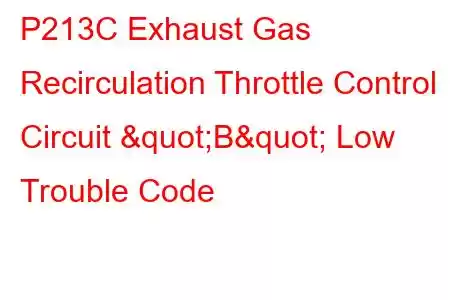P213C EGR Throttle Position Control Circuit B Low
OBD-II Trouble Code Technical Description
Exhaust Gas Recirculation Throttle Position Control Circuit "B" Low
What does that mean?
This generic powertrain/engine diagnostic trouble code typically applies to OBD-II vehicles. Vehicle brands may include but are not limited to Jeep, Chrysler, Dodge, Ford, GM, Chevy, etc.
This exhaust gas recirculation (EGR) throttle control valve is placed in between the intake manifold and the air filter, similar to a throttle body. It is used to create a small vacuum that will draw exhaust gases into the intake manifold.
The Powertrain Control Module (PCM) tells the Exhaust Gas Recirculation (EGR) throttle control valve where to position itself. This code is looking at the voltage signals from the EGR throttle control valve to determine if they are correct based on inputs to the PCM. This code could have been set most likely due to electrical issues. In this case, P213C refers to a low voltage condition on that control circuit.
Troubleshooting steps may vary depending upon manufacturer, type of EGR throttle control valve and wire colors.
Symptoms
Symptoms of a P213C engine code may include:
Malfunction Indicator Lamp (MIL) illuminated Longer than normal active aftertreatment regeneration times (it will take longer for the exhaust system to get hot and burn off the soot that has built up inside the diesel particulate filter/catalytic converter)Causes
Potential causes for this code to set are:
Short to voltage, ground, or other fault in the signal circuit to the EGR throttle control valve EGR throttle control valve faulty – internally shorted Failed PCM - unlikelyDiagnostic and Repair Procedures
A good starting point is always to check for technical service bulletins (TSB) for your particular vehicle. Your issue may be a known issue with a known fix put out by the manufacturer and can save you time and money during diagnosis.
Next, locate the EGR throttle control valve on your particular vehicle. This valve is found in between the intake manifold and the air filter, similar to a throttle body. Once located, visually inspect the connectors and wiring. Look for scraping, rubbing, bare wires, burn spots or melted plastic. Pull the connectors apart and carefully inspect the terminals (the metal parts) inside the connectors. See if they look burned or have a green tint indicating corrosion. Use electrical contact cleaner and a plastic bristle brush if cleaning of the terminals is needed. Let dry and apply dielectric silicone grease where the terminals contact.
If you have a scan tool, clear the diagnostic trouble codes from memory, and see if this code returns. If it does not, then the connections were most likely your problem.
If the P213C code does return, we will need to test the EGR throttle control valve and its associated circuits. Typically, there are either 3 or 4 wires at the EGR throttle control valve. Disconnect the harness going to the EGR throttle control valve. With a Digital Volt Ohm Meter (DVOM), test the EGR throttle control valve signal circuit (Red lead to the valve’s signal circuit, black lead to a good ground). If there is no 5 volts to the valve, or if you see 12 volts at the valve, repair the wiring from the PCM to the valve, or possibly a bad PCM.
If that’s OK, check to make sure you have a good ground at the EGR throttle control valve. Connect a test light to 12V battery positive (red terminal) and touch the other end of the test light to the ground circuit going to the EGR throttle control valve circuit ground. If the test light does not light up, this would indicate the problem circuit. If it does light up, wiggle the wiring harness going to the EGR throttle control valve to see if the test light flickers, indicating an intermittent connection.
If all prior tests have passed and you continue to get a P213C, this would most likely indicate a failed EGR throttle control valve, although a failed PCM could not be ruled out until the EGR throttle control valve had been replaced.
Read: 29


